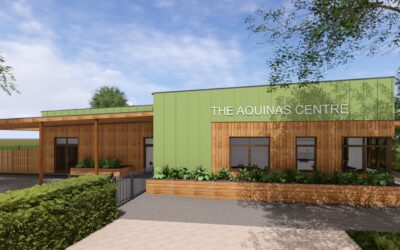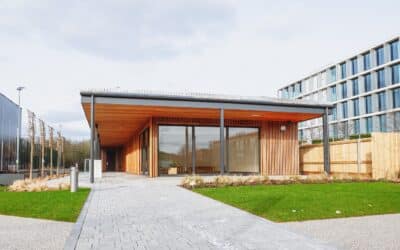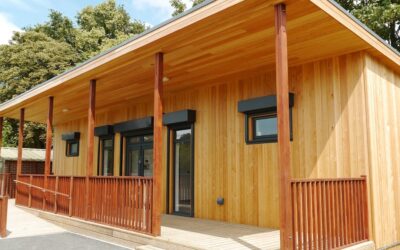TG Escapes Blog
Analysing the “Timber in Construction Roadmap”
In December 2023 the government published its “Timber in Construction Roadmap” policy paper, outlining its long-term goals for the industry and the steps it will take to meet them, including financial commitments, clear targets, and the establishment of advocacy groups. TG Escapes has long championed the use of sustainable timber within construction work as the best solution to meet both the need for new buildings and the need to limit global CO2 emissions, so our team were curious to see how this document would align.
Why timber?

According to Chris Leese, Design Manager and Structural Engineer at TG Escapes
“Timber is one of the only truly sustainable products in construction. It can be reused, recycled, and repurposed as fuel, and it will store carbon throughout its lifecycle until the time it is repurposed. While other materials such as steel can be recycled, they don’t act as carbon sinks during their lifecycle.”
As the government points out in their roadmap “Use of timber can reduce the embodied emissions in a single building by 20% to 60%”, and yet only 9% of new homes in England are timber framed, meaning that industry changes are needed. While other materials like concrete and steel will still have a role to play, timber can be used for everything from structural framing to panelling, doors, flooring, sheathing and more. Particularly when taking advantage of MMC (Modern Methods of Construction), we believe that timber is the simple, effective choice for a wide range of buildings, from homes to schools to larger blocks.
What’s in the roadmap?
The “Timber in Construction Roadmap” represents a clear and cohesive approach towards changing the construction industry to better utilise timber. It proposes various changes from both the government and the construction industry, across things like domestic timber production, training and job creation, and data around carbon sequestration. Crucially, it aims to align the actions in the timber sector with broader environmental goals, ensuring a cohesive approach to sustainable construction. The roadmap is broken into seven distinct sections.
Section 1: Improving data on timber and whole life carbon
The government will work with the construction industry to try and reduce embodied carbon in new buildings, potentially imposing limits in the future. They’ll also look to expand the evidence base around embodied carbon and timber, to reduce the carbon emissions that come from timber at the end of its life. Use of the newly established Built Environment Carbon Database is also encouraged, offering a consistent source for carbon estimating and benchmarking.

Section 2: Promoting the safe, sustainable use of timber as a construction material
In this section the government outlines its commitments to MMC techniques like modular, looking at building new homes and schools, alongside using timber to retrofit older buildings. They will also promote timber through a series of campaigns and web platforms to encourage its use. They recognise that MMC methods can offer a quick, sustainable way to build homes that offer resource efficiency across their lives.
Section 3: Increasing skills, capacity, and competency across the supply chain
This push towards increased timber construction will require a workforce skilled in its use. The government’s approach is built from the ground up, with a focus on school and college courses, further education, apprenticeships and training provisions. An industry forum on meeting skilled labour needs will also be held by 2025.
Section 4: Increasing the sustainable supply of timber
Having the timber to back up these commitments is another important matter, and the government is looking for options to increase the yield of both softwood and hardwood timber in the UK. The UK is also committed to stopping forest loss, so all of these increases will need to be sustainable. All timber sourced internationally will also need to be from a managed forest to contribute to the carbon targets of a building.

Section 5: Addressing fire safety and durability concerns to safely expand the use of engineered mass timber
While the government acknowledges that the building industry is capable of safely using timber frames, it wants the expansion into mass timber buildings to come with a robust backing of research to ensure fire safety. This research will be built up over the next 5 years.
Section 6: Increasing collaboration with insurers, lenders, and warranty providers
The use of engineered mass timber in construction has raised concerns for insurers and warranty providers, primarily relating to fire safety, water damage, and durability. To address these concerns, the Mass Timber Insurance Playbook has been launched, guiding risk assessment and insurance procurement across timber buildings. The government and industry also aim to establish a risk register by 2028, featuring anonymized data on mass timber buildings, including international insights. This initiative also seeks to enhance communication between insurance companies and developers.
Section 7: Promoting innovation and high-performing timber construction systems
Finally, the government wants to encourage the wood product sector to innovate, focusing on reducing carbon emissions and improving resource efficiency. The roadmap advocates for advanced building practices, like off-site manufacturing and digital technologies, to increase productivity and minimise waste. They also want to explore the well-being benefits of timber, including through the construction of a biophilic primary school. Collaborative research efforts will be aimed at optimising timber construction’s carbon performance, promoting circularity, and ensuring safety, demonstrating the potential of timber in modern construction.
Our thoughts on the roadmap
We’re happy with the roadmap overall, and think that it’s a positive sign to see so many of the aspects of timber we’ve been talking about for decades become part of government policy. It’s especially positive to see mentions of producing a biophilic primary school, as we have been advocating for the benefits of biophilia for many years, particularly in education. We think that timber is the clear choice for creating buildings that meet net zero requirements, and that the modular approach offers a swift, accurate, and cost-effective way to install them. We’re also pleased to see MMC in general and modular in specific receive mentions within the roadmap.
Our concerns at the moment are around the speed of implementation. While the roadmap is a step in the right direction, we can’t help but feel that the speed of travel is too slow. We’d also have liked more clarification on plans to develop the UK timber industry, alongside additional investment into the recycling of timber.
Responding to concerns around fire safety and longevity
As experts in timber buildings, having produced over 800 commercial and domestic structures over the past two decades, we understand better than most how wooden structures can be prepped for stellar fire safety and effortless long-term use. Chris Leese, our design manager and structural engineer, had this to say.
On creating fire solutions in timber buildings
“Fire has always been a concern in timber structures for clients; however, solutions have been found in encapsulation, where we cover the timber up with boarding or intumescent (fire-resistant) paint. Timber also possesses an inherent strength that isn’t lost in a fire. Compare this to steel, which starts losing its strength well below the temperature at which timber even starts burning. Timber brings both low carbon emissions and biophilic benefits to a building, making it crucial that a route is found to deliver timber in suitable structures.”
On building for 50 years of performance

The timber in Greensted Church is nearly 1000 years old
“We quote a lifespan of 50 years on our buildings, but timber has been used as a construction material for millennia and there’s a wealth of evidence that well-maintained timber buildings can survive. For example, Greensted church in Essex dates back to 845, with its timber carbon dating to around 1053. Looking further around the world, the Horyu-ji temple in Ikaruga, Japan can be dated to 607. I would argue the evidence for long-term timber buildings is already there, with clear principles of moisture control alongside insect and fungal treatments, such as those laid out by BM Trada, helping the industry meet performance targets.”
Preparing for the future of timber construction
TG Escapes has been at the forefront of the timber building industry for many years, utilising sustainable wood as part of a suite of net zero building projects. As laid out in the roadmap, using timber within modern methods of construction is the best approach to balance the need for new buildings with the need to curb emissions. While our team have some reservations about the speed of change offered by the roadmap, it clearly shows that the government has come to the same conclusion we have, that timber is the best choice for sustainable construction in the future.
To find out more about our range of timber buildings, explore some of our case studies, or speak to a member of our team.
About the author
More posts from our blog
Education Estates 2025: Surrey County Council Share Their SEND Provision Strategy, Including the Contribution Made by TG Escapes
At the recent Education Estates 2025 conference, I was proud to join Euan Leslie, Programme Manager for our partners Surrey County Council as we presented their ambitious and highly successful strategy for expanding Special Educational Needs and Disabilities (SEND)...
The Benefits of Choosing a Modular Clubhouse Building
A clubhouse needs to serve many functions, from creating social spaces and meeting areas to offering changing rooms and toilet facilities for players. Modular buildings are an ideal solution for creating flexible, purpose-built facilities for sports teams,...
Supporting Active School Life With Modular Sports Pavilions
Physical activity is a crucial part of everyday schooling across the UK. But in many settings, ageing facilities and limited space can prevent pupils from getting the full benefit of PE, sport, and outdoor recreation. Modern sports and leisure pavilions offer an...



